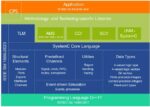In the early days an IC had a single clock and a single reset signal, making it a simple matter to reset the chip into a known, stable state, so there was little need for detailed analysis. For modern designs there can be dozens to hundreds of clocks, creating separate domains and some use of asynchronous resets, so the challenge of ensuring… Read More
Author: Daniel Payne
Reset Domain Crossing (RDC) Challenges
Electrical Rule Checking in PCB Tools
I’ve known about DRC (Design Rule Checking) for IC design, and the same approach can also be applied to PCB design. The continuous evolution of electronics has led to increasingly intricate PCB designs that require Electrical Rule Checking (ERC) to ensure that performance goals are met. This complexity poses several challenges… Read More
SystemC Update 2024
SystemC version 1.0 came out in 2000 as a C++ class library for system-level modeling and simulation, and on SemiWiki.com there are some 497 references to the language. I wanted to provide an update in this blog so that engineering teams can become more efficient in using SystemC on their SoC projects, saving time and improving product… Read More
Handling Objections in UVM Code
You begin writing some UVM code and there are parts of the code that aren’t done yet, so you begin to use uvm_objection, guarding that code. Rich Edelman, a product engineer at Siemens doing verification debug and analysis, wrote a paper on this topic, which I just read. This blog covers the topic of objections and provides some different… Read More
Analog IC Migration using AI
My first job out of college was migrating a DRAM chip from one process node to a newer node, and it was a 100% manual process that required many months of effort. That need to migrate semiconductor IP to newer nodes is still with us today, and much automation has been applied to digital circuits, however migrating analog IP has proven… Read More
Next Generation of Systems Design at Siemens
Electronic systems design is filled with a wide range of tools used across IC packaging design, multi-board systems, design creation, physical implementation, electro-mechanical co-design, simulation & analysis, and new product introduction. Siemens has been offering tools in this flow for many years now, so I was able… Read More
Signal Integrity Basics
PCB and package designers need to be concerned with Signal Integrity (SI) issues to deliver electronic systems that work reliably in the field. EDA vendors like Siemens have helped engineers with SI analysis using a simulator called HyperLynx, dating all the way back to 1992. Siemens even wrote a 56-page e-book recently, Signal… Read More
New Product for In-System Test
The annual ITC event is happening this week in San Diego as semiconductor test professionals gather from around the world to discuss their emerging challenges and new approaches, so last week I had the opportunity to get an advance look at something new from Siemens named Tessent In-System Test software. Jeff Mayer, Product Manager,… Read More
SI and PI Update from Cadence on Sigrity X
Signal Integrity (SI) and Power Integrity (PI) issues are critical to analyze, ensuring the proper operation of PCB systems and IC packages, yet the computational demands from EDA tools can cause engineers to only analyze what they deem are critical signals, instead of the entire system. Cadence has managed to overcome this SI/PI… Read More
Smarter, Faster LVS using Calibre nmLVS Recon
Back in the 1970s we did Layout Versus Schematic (LVS) checks manually, so when internal EDA tools arrived in the 1980s it was a huge time saver to use LVS in finding the differences between layout and schematics. One premise before running LVS is that both layout and schematics are complete and ready for comparisons. Fast forward… Read More





















Quantum Computing Technologies and Challenges